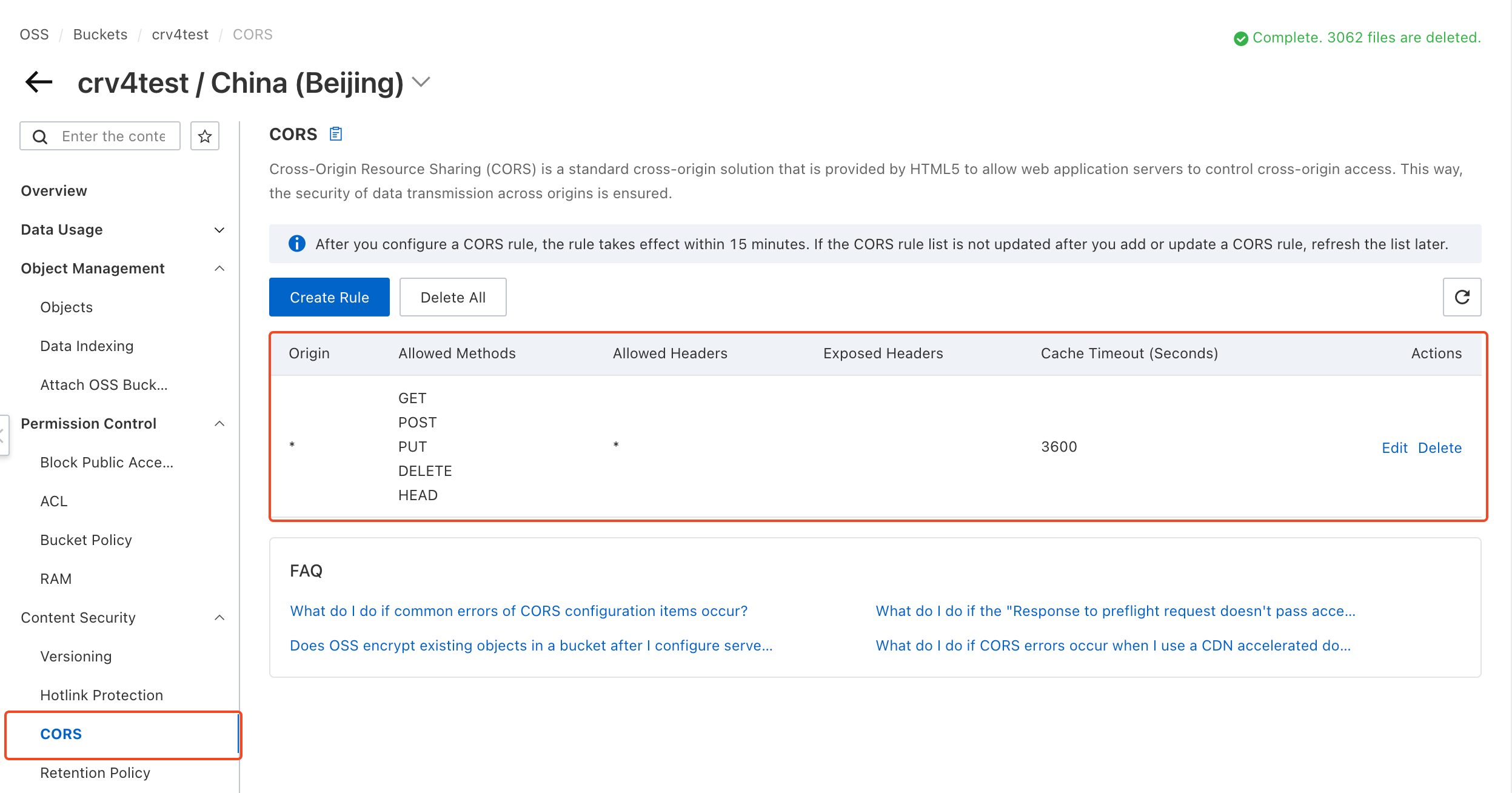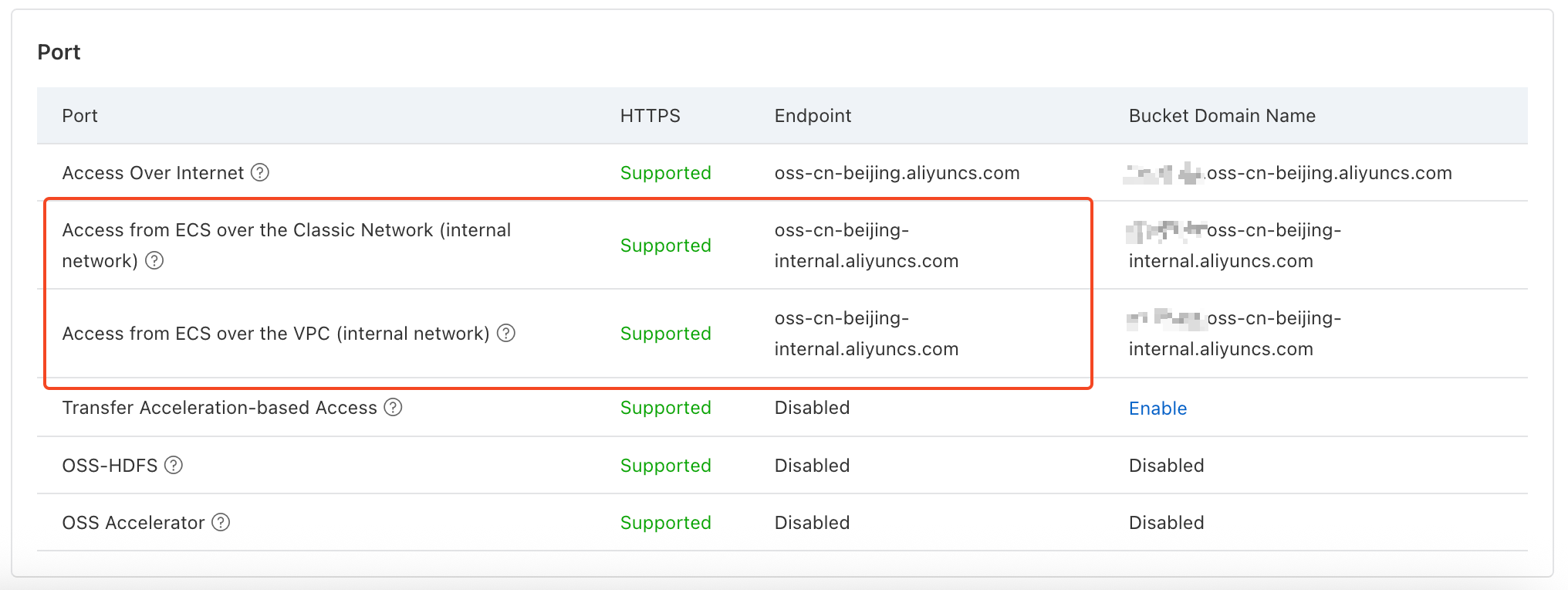Alibaba Cloud OSS
Using Alibaba Cloud OSS buckets to store files.
Configuration
CORS Policy
The bucket needs to be configured with a CORS policy before it can be used with Cloudreve's web client for uploading or browsing files. Normally, you can let Cloudreve automatically configure the CORS policy while adding a storage policy. If you need to configure it manually, please add it in Content Security -> CORS.

Intranet Endpoint
If your Cloudreve is deployed on Alibaba Cloud ECS and is in the same availability zone as your OSS, you can additionally specify an intranet endpoint to save network traffic costs. Cloudreve will switch to the intranet endpoint when conditions are met.

When you configure an intranet endpoint for a storage policy, the following scenarios will switch to the intranet endpoint:
- Server-side transfer upload;
- Server-side relayed upload (when storage policy has
Upload relayenabled); - File management requests (delete, create upload session, etc.);
- Server-side relayed download (when storage policy has
Download relayenabled); - Other requests that require the server to download files;
When using slave nodes to process tasks, the public endpoint will be used.
Using Custom Domain Endpoint
If you only need to use a custom domain (such as a CDN) in file download URLs, you can configure a Download CDN in the storage policy. After configured, the hostname and path in the file download URL will be replaced with the CDN URL you provided, but file upload and management requests will still use the official endpoint provided by OSS. This section will explain how to configure a custom endpoint for all requests.
Prepare Custom Domain
Please set up your custom domain with a CNAME record or reverse proxy to the Bucket Domain Name with the Bucket name prefix. Add and verify this domain in the OSS bucket configuration under Bucket Setting -> Domain Names.
If you don't want to add your custom domain in the OSS bucket configuration, you can still proceed, but your domain must reverse proxy to the Bucket Domain Name - direct CNAME resolution won't work. When configuring the reverse proxy, please rewrite the request Host header to the official Bucket Domain Name with the Bucket name, otherwise OSS cannot identify your Bucket. Reference configuration methods:
location / {
proxy_pass https://<bucket-name>.oss-<region>.aliyuncs.com;
proxy_set_header Host <bucket-name>.oss-<region>.aliyuncs.com;
}WARNING
Whether using reverse proxy or CNAME resolution, the target endpoint must be the Bucket Domain Name with the Bucket name prefix. Don't mistakenly use the Endpoint without the Bucket name prefix.
Enable Custom Endpoint
Fill in your custom domain in the storage policy configuration under Basic Information -> Endpoint, and check the This is a custom domain option.
FAQ
Upload error: Unable to complete file upload: Private address is forbidden to callback. (InvalidArgument)
Please check if the Main Site URL under Settings -> Basic is correctly set. It must be an address accessible from the public internet.
Upload error: Unable to complete file upload: xxxxx (CallbackFailed)
This error indicates that OSS cannot reach your callback URL. Please check if the Main Site URL under Settings -> Basic is correctly set. It must be an address accessible from the public internet.
In the error message, xxxx is the specific error when requesting the callback address. Please troubleshoot based on this error information.
Upload error: Unable to create upload session: xxxxx The bucket you are attempting to access must be addressed using the specified endpoint. Please send all future requests to this endpoint
- Check the
Endpointsetting in the storage policy, avoid checking theThis is a custom domainoption when using the official endpoint; - If you are using a custom endpoint:
- Make sure it points to the
Bucket Domain Namewith the Bucket name, not the officialEndpoint; - Make sure you've added and verified this custom domain in your OSS bucket configuration; or that you've correctly rewritten the
Hostheader in your reverse proxy configuration;
- Make sure it points to the
Relay upload failed, error: Unable to parse response
Expand the detailed error, check if the error message contains
413 Request Entity Too LargeIf yes, please modify the Nginx reverse proxy configuration, set or increase the value of
client_max_body_size, for exampleclient_max_body_size 20000m;. This value should be greater than the size of the uploaded file.Check if an external WAF firewall is blocking the upload request.
Upload error: Request failed: AxiosError: Network Error xxx
Check if the
Endpointsetting in the storage policy is correct:- Whether the user side can access this Endpoint;
- If the site is using HTTPS, please ensure that the Endpoint you filled in is also HTTPS, and a valid SSL certificate is configured;
Check if the bucket CORS policy is set and if it is correct;